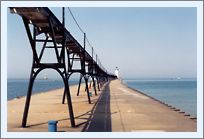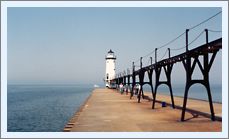|
Historical
Information

Although the first sawmill had been established on the banks of the
Manistee in 1841, settlement in the area was not widespread until the
Chippewa relinquished their reservation by treaty in 1849, and the
federal government offered lands along the Manistee for public sale. It
did not take lumber interests long to realize the incredible potential
of the Manistee which snaked a hundred miles into the forests, and
lumbermen soon began lobbying for federal funding to improve the harbor
and to erect a lighthouse at the river mouth. With no appropriation
forthcoming, the businessmen of Manistee took the matter into their own
hands, erecting a pair of short stub piers at the river mouth in an
attempt to stem the deposition of sand and silt.
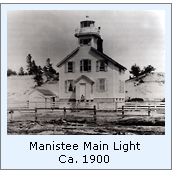 In 1861, Congress instructed the Army Corps of Engineers to dispatch
an Engineer Officer to Manistee to conduct a survey of the river
entrance. Water depth in the opening between the piers was found to be
from seven to eight feet, and a 250-foot long sand bar with a water
depth of less than five feet above it was identified 600 feet off the
end of the piers. While the Engineer’s report indicated that harbor
improvements at Manistee were both necessary and valid, nothing would be
done until 1867 when appropriations were simultaneously approved for
improvements to the river entrance and for the erection of a lighthouse
to guide vessels into the new entry on its completion. A survey party
was sent to Manistee in 1876 to select and survey a site on the north
shore of the river mouth for the new lighthouse reservation. While the
new Manistee Light
was completed in 1870, a devastating fire swept though the area on
October 6, 1871, completely destroying the to its foundation. Congress
appropriated funds for the construction of a new lighthouse which was
erected the following year. In 1861, Congress instructed the Army Corps of Engineers to dispatch
an Engineer Officer to Manistee to conduct a survey of the river
entrance. Water depth in the opening between the piers was found to be
from seven to eight feet, and a 250-foot long sand bar with a water
depth of less than five feet above it was identified 600 feet off the
end of the piers. While the Engineer’s report indicated that harbor
improvements at Manistee were both necessary and valid, nothing would be
done until 1867 when appropriations were simultaneously approved for
improvements to the river entrance and for the erection of a lighthouse
to guide vessels into the new entry on its completion. A survey party
was sent to Manistee in 1876 to select and survey a site on the north
shore of the river mouth for the new lighthouse reservation. While the
new Manistee Light
was completed in 1870, a devastating fire swept though the area on
October 6, 1871, completely destroying the to its foundation. Congress
appropriated funds for the construction of a new lighthouse which was
erected the following year.
1874 and 1875 were exceptionally busy years for Manistee, with 3,488,
vessels entering the river between June 30, 1874, and June 30, 1875. To
serve this burgeoning maritime commerce, the piers were extended an
additional 150 feet in 1875, and the channel between them dredged to a
minimum depth of ten feet. With the main light now standing a
considerable distance to the rear of the pierheads, the decision was
made to replace the shore light on the north bank with a pierhead beacon
on the outer end of the longer south pier. 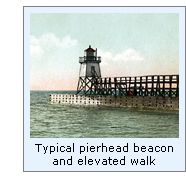 The new south pierhead light
consisted of a timber-framed pyramidal beacon typical of the type being
erected on pierheads throughout the Great Lakes. With its lower half
open, the upper half immediately below the gallery was enclosed to
provide a small service room for lamp maintenance. Equipped with
windows, the service room also served as a sheltered area in which the
keeper could stand watch during inclement weather. Standing 27 feet in
height, the beacon was capped with a square gallery with iron handrails
and an octagonal cast iron lantern installed at its center. The fixed
red Fifth Order lens was removed from the main light and reinstalled in
the new beacon, where its 35-foot focal plane afforded a range of
visibility of 11 miles in clear weather. An elevated timber walkway lead
from shore to a door in the service room, allowing the keepers to access
the light in relative safety when storm-driven waves crashed across the
surface of the pier. Keeper McKee rowed across the river to exhibit the
new light on the night of October 15, 1875, and with the establishment
of the new light, the main light was officially discontinued.
The new south pierhead light
consisted of a timber-framed pyramidal beacon typical of the type being
erected on pierheads throughout the Great Lakes. With its lower half
open, the upper half immediately below the gallery was enclosed to
provide a small service room for lamp maintenance. Equipped with
windows, the service room also served as a sheltered area in which the
keeper could stand watch during inclement weather. Standing 27 feet in
height, the beacon was capped with a square gallery with iron handrails
and an octagonal cast iron lantern installed at its center. The fixed
red Fifth Order lens was removed from the main light and reinstalled in
the new beacon, where its 35-foot focal plane afforded a range of
visibility of 11 miles in clear weather. An elevated timber walkway lead
from shore to a door in the service room, allowing the keepers to access
the light in relative safety when storm-driven waves crashed across the
surface of the pier. Keeper McKee rowed across the river to exhibit the
new light on the night of October 15, 1875, and with the establishment
of the new light, the main light was officially discontinued.
While the main light no longer served as an aid to navigation, the
structure continued to serve as the keeper’s dwelling, and thus the
keeper was forced to row across the river numerous times during each day
and night to tend the pierhead light. However, McKee’s inconvenience
was short-lived, as he was removed from his position on October 26, 1875
and William King appointed as his replacement.
With work continuing on the piers in 1879, the pierhead beacon was
moved 156 feet to the revised end of the south pier, and the elevated
walk extended to fill the resulting gap. The following year, the
dwelling was thoroughly repaired, and a new well sunk to provide a
supply of fresh drinking water for Keeper King and his family.
Traffic in and out of the river continued to increase throughout the
1880’s. To better serve this traffic, Eleventh District Engineer Major
Samuel M. Mansfield recommended an appropriation of $5,000 for the
erection of a fog signal on the south pier to serve as a guide to
mariners during thick or foggy weather in his report for 1888. Congress
responded with the requested appropriation on March 2, 1889, and bids
for furnishing the labor, construction materials and mechanical
equipment were advertised and awarded that same year. The following
spring, a work crew arrived at Manistee to undertake a number of
improvements on the south pier.
First, a tubular lantern was erected on a pole at the outer end of
the newly extended south pier to serve as a front range for the pierhead
beacon. The lantern was suspended from a cable which passed around a
pair of pulleys, with one pulley secured to the pole at the at the
pierhead, and the other inside a window installed on the lakeward side
of the beacon service room. This system was designed to allow the keeper
to service the tubular lantern from within the confines of the service
room, and then transport the light out along the cable to the pierhead.
After completion of this new light, the crew turned its attention to the
erection of the new fog signal building.
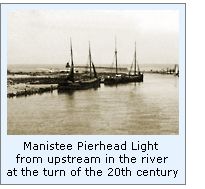 Typical of such structures being erected throughout the Great Lakes,
the fog signal building was built on the pier immediately behind the
beacon, and connected to the beacon by a short length of elevated walk.
Timber-framed, and sheathed with brown-painted corrugated iron sheeting,
the structure housed a pair of horizontal boilers piped to a pair of
10-ich locomotive whistles installed atop the roof. The interior of the
structure was also outfitted with a coal bin, water supply tank and a
work bench to give the keepers an area on which to perform maintenance
on the signal equipment. Construction of the new building continued
through the winter, with the signals finally tested and placed into
operation on February 10, 1890. With the establishment of the new fog
signal, the decision was made to add an assistant to the station’s
roster, with John Langland Jr. arriving to fill the position on January
15. Typical of such structures being erected throughout the Great Lakes,
the fog signal building was built on the pier immediately behind the
beacon, and connected to the beacon by a short length of elevated walk.
Timber-framed, and sheathed with brown-painted corrugated iron sheeting,
the structure housed a pair of horizontal boilers piped to a pair of
10-ich locomotive whistles installed atop the roof. The interior of the
structure was also outfitted with a coal bin, water supply tank and a
work bench to give the keepers an area on which to perform maintenance
on the signal equipment. Construction of the new building continued
through the winter, with the signals finally tested and placed into
operation on February 10, 1890. With the establishment of the new fog
signal, the decision was made to add an assistant to the station’s
roster, with John Langland Jr. arriving to fill the position on January
15.
The volume of traffic along the coast heading to and from the Straits
continued to increase, and in 1893 the decision was made to reactivate
the old main light to serve double duty as both a coast light and to
better guide mariners to the river mouth. The futility of having the
keepers simultaneously attend the reactivated main light on the north
side of the river and the fog signal and the ranges on the south pier
became clear, and thus plans were also put in place to relocate the fog
signal and pierhead light to the north pier at the opening of the
following navigation season.
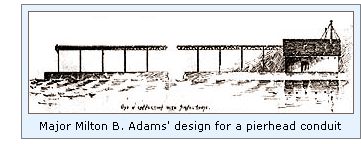 In May of 1894, a work crew arrived at Manistee moved the fog signal
building from the south pier to a new timber foundation that had been
erected 300 feet from the outer end of the north pier. Rather than
relocating the old pierhead beacon, Major Milton B. Adams instead
decided to install one of his newly designed conduit systems on the
north pierhead. Supported by trestles, a wooden conduit box lead from
the pierhead, 290 feet to an opening in the lakeward wall of the fog
signal building. The conduit contained a set of iron rails on which a
steel trolley was located. The lens was mounted atop this trolley, and
could be moved back and forth within the conduit from the fog signal
building to the pierhead. 460 feet of new elevated walk was also
installed from the rear of the fog signal building toward the shore. The
old elevated walk was then removed from the south pier, and 463 feet of
it reinstalled on the north pier, bringing the total length of elevated
walk on the north pier to 923 feet. The old Main Light was reactivated
on June 18, 1894, and the ranges on the south pier discontinued and
removed. In May of 1894, a work crew arrived at Manistee moved the fog signal
building from the south pier to a new timber foundation that had been
erected 300 feet from the outer end of the north pier. Rather than
relocating the old pierhead beacon, Major Milton B. Adams instead
decided to install one of his newly designed conduit systems on the
north pierhead. Supported by trestles, a wooden conduit box lead from
the pierhead, 290 feet to an opening in the lakeward wall of the fog
signal building. The conduit contained a set of iron rails on which a
steel trolley was located. The lens was mounted atop this trolley, and
could be moved back and forth within the conduit from the fog signal
building to the pierhead. 460 feet of new elevated walk was also
installed from the rear of the fog signal building toward the shore. The
old elevated walk was then removed from the south pier, and 463 feet of
it reinstalled on the north pier, bringing the total length of elevated
walk on the north pier to 923 feet. The old Main Light was reactivated
on June 18, 1894, and the ranges on the south pier discontinued and
removed.
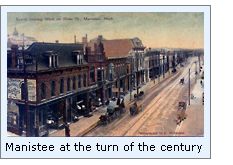 With a continuing increase in maritime commerce through the late
nineties, Manistee was in a state of metamorphosis. Undergoing the
inevitable "gentrification" that results from a massive influx
of business people and wealth, many of the newer residents found their
sensibilities insulted by the caterwauling of the fog whistle out on the
north pierhead, and began raising their voices in both disgust and
concern. A similar set of circumstances had unfolded previously at the
Duluth South Breakwater Light in 1895, where the sound of the fog signal
bounced from the hillsides around the harbor, upsetting the city
residents. Needing the support of the local maritime community, the
Lighthouse Board had undertaken an experiment whereby a large wooden
parabolic reflector had been constructed around the Duluth whistles.
Designed to concentrate the sound on the lake side of the whistle, while
simultaneously shielding the city side from much of the noise, the
experiment had been considered to be an unqualified success. Thus the
decision was made to undertake a similar modification to the Manistee
whistles, and a crew arrived at Manistee in 1897 and crafted a reflector
framework of pine, sheathed in iron and packed with sawdust to deaden
the sound. The whistles were then re-piped into the center of the
reflector, and a semblance of peace restored to the citizenry of
Manistee. With a continuing increase in maritime commerce through the late
nineties, Manistee was in a state of metamorphosis. Undergoing the
inevitable "gentrification" that results from a massive influx
of business people and wealth, many of the newer residents found their
sensibilities insulted by the caterwauling of the fog whistle out on the
north pierhead, and began raising their voices in both disgust and
concern. A similar set of circumstances had unfolded previously at the
Duluth South Breakwater Light in 1895, where the sound of the fog signal
bounced from the hillsides around the harbor, upsetting the city
residents. Needing the support of the local maritime community, the
Lighthouse Board had undertaken an experiment whereby a large wooden
parabolic reflector had been constructed around the Duluth whistles.
Designed to concentrate the sound on the lake side of the whistle, while
simultaneously shielding the city side from much of the noise, the
experiment had been considered to be an unqualified success. Thus the
decision was made to undertake a similar modification to the Manistee
whistles, and a crew arrived at Manistee in 1897 and crafted a reflector
framework of pine, sheathed in iron and packed with sawdust to deaden
the sound. The whistles were then re-piped into the center of the
reflector, and a semblance of peace restored to the citizenry of
Manistee.
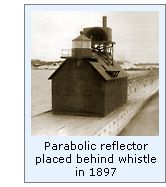 Adams’ experiment with his new conduit system proved to be less
than successful, and the system at Manistee was removed from the north
pierhead in 1900. At the same time, the fog signal building was moved
260 feet to a point 42 feet from the pierhead, and installed atop a
two-foot high timber foundation. A gallery and octagonal cast iron
lantern were then installed on the lakeward gable end of the fog signal
building, and the lantern outfitted with a new fixed red Sixth Order
Fresnel lens. To clear the new lantern, the fog whistle and deflector
were raised by 4 feet. Adams’ experiment with his new conduit system proved to be less
than successful, and the system at Manistee was removed from the north
pierhead in 1900. At the same time, the fog signal building was moved
260 feet to a point 42 feet from the pierhead, and installed atop a
two-foot high timber foundation. A gallery and octagonal cast iron
lantern were then installed on the lakeward gable end of the fog signal
building, and the lantern outfitted with a new fixed red Sixth Order
Fresnel lens. To clear the new lantern, the fog whistle and deflector
were raised by 4 feet.
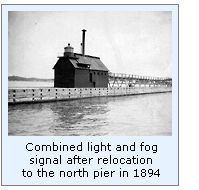 In 1914, the Army Corps of Engineers were again at Manistee
overseeing the erection of a breakwater on the south side of the harbor.
In concert with the elongated north pier, the two structures formed a
large stilling basin, ensuring calm water at the channel entrance. With
completion of the breakwater on April 6, 1914, a red steel skeleton
tower was established 80 feet from the outer end of the breakwater.
Equipped with an acetylene powered flashing red 300 mm lens standing 45
feet above the water, the 60-candlepower light was visible for 7 miles,
and the Manistee keepers once again found themselves responsible for
three lights and a first-class fog signal. With the availability of
municipal electricity, all three lights were electrified in 1925, with a
commensurate increase in both candlepower and visible range. In 1914, the Army Corps of Engineers were again at Manistee
overseeing the erection of a breakwater on the south side of the harbor.
In concert with the elongated north pier, the two structures formed a
large stilling basin, ensuring calm water at the channel entrance. With
completion of the breakwater on April 6, 1914, a red steel skeleton
tower was established 80 feet from the outer end of the breakwater.
Equipped with an acetylene powered flashing red 300 mm lens standing 45
feet above the water, the 60-candlepower light was visible for 7 miles,
and the Manistee keepers once again found themselves responsible for
three lights and a first-class fog signal. With the availability of
municipal electricity, all three lights were electrified in 1925, with a
commensurate increase in both candlepower and visible range.
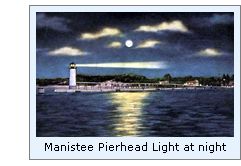 After major improvements to both the north and south piers in 1927,
the old fog signal building was removed, and replaced by a 39 foot-tall
iron tower on the outer end of the south pier. Capped with a decagonal
steel lantern outfitted with a Fifth Order Fresnel, the light was
equipped with a 5,000 candlepower incandescent electric bulb equipped
with a flashing mechanism which exhibiting a group occulting white light
with a period of 30 seconds. Sitting at a focal plane of 55 feet, the
new light was visible for a distance of 15 miles in clear weather
conditions. A single "Type C" diaphone powered by an electric
compressor was housed within the tower, and emitted a characteristic
similar to the light consisting of a group of three blasts every 30
seconds. With the erection of this new tower, the old wooden elevated
walk was torn down, and replaced by a cast iron walkway. After major improvements to both the north and south piers in 1927,
the old fog signal building was removed, and replaced by a 39 foot-tall
iron tower on the outer end of the south pier. Capped with a decagonal
steel lantern outfitted with a Fifth Order Fresnel, the light was
equipped with a 5,000 candlepower incandescent electric bulb equipped
with a flashing mechanism which exhibiting a group occulting white light
with a period of 30 seconds. Sitting at a focal plane of 55 feet, the
new light was visible for a distance of 15 miles in clear weather
conditions. A single "Type C" diaphone powered by an electric
compressor was housed within the tower, and emitted a characteristic
similar to the light consisting of a group of three blasts every 30
seconds. With the erection of this new tower, the old wooden elevated
walk was torn down, and replaced by a cast iron walkway.
The city of Manistee has done an incredible job of downtown
restoration, and has aptly earned the nickname of "Lake Michigan’s
Victorian Port City." The downtown shopping district has been
restored, and walkways along the river banks lead down to the lakeshore
where the 1927 north pierhead light and elevated walkway still stand
guard over the harbor entrance.

Keepers of this Light

Click Here to see
a complete listing of all Manistee Light keepers compiled by Phyllis L.
Tag of Great Lakes Lighthouse Research.

Seeing this Light

The weather was perfect at
Manistee. The sun burned-off the clouds, the breeze dropped to an almost
imperceptible level, and the lake laid-down flat as a billiard
table.
We walked the pier, and looked at the catwalk, which runs the entire
length of the pier.
We wondered at how rough the weather must get in the fall and spring to
require such a structure to be built. On a day such as this, it was difficult to think of this place as
anything other than a peaceful place to walk!

Finding this Light

From US31, take Memorial Drive West approximately one mile to the Lake.
Note that Memorial Drive changes to 5th Avenue along the way.

Contact
information
Manistee County Historical Museum
425 River Street
Manistee, MI 49660
(616) 723-5531

Reference Sources
Journals of the US Senate and
House of Representatives, various, 1851 - 1872
Annual report of the Fifth Auditor of the Treasury, 1838
History of Manistee county, Michigan, H.R. Page & Co.,
Chicago, 1882
History of the Great Lakes, J H Beers Co., 1899
Annual reports of the Lighthouse Board, various, 1852 - 1909
Annual reports of the Lake Carriers Association, various, 1914 -
1930
Around the Shores of Lake Michigan, Margaret Beattie Bogue, 1985
Personal observation at Manistee, 09/05/1998.
Keeper listings for this light appear courtesy of Great
Lakes Lighthouse Research
|
